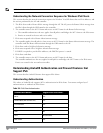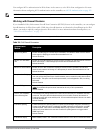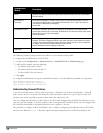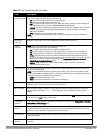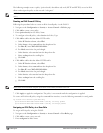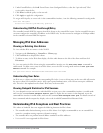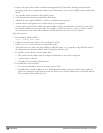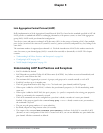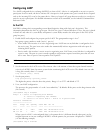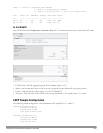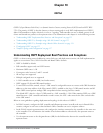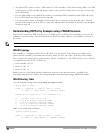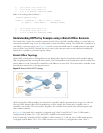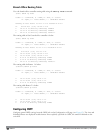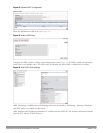
149 | DellPowerConnectW-SeriesArubaOS6.2 | User Guide
Configuring LACP
Two LACP configured devices exchange LACPDUs to form a LAG. A device is configurable as an active or passive
participant. In active mode, the device initiates DUs irrespective of the partner state; passive mode devices respond
only to the incoming DUs sent by the partner device. Hence, to form a LAG group between two devices, one device
must be an active participant. For detailed information on the LACP commands, see the ArubaOS Command Line
Reference Guide.
In the CLI
LACPDUs exchange their corresponding system identifier/priority along with their port’s key/priority. This
information determines the LAG of a given port. The LAG for a port is selected based on it’s keys; the port is placed
in that LAG only when it’s system ID/key and partner's system ID/key matches the other ports in the LAG (if the
group has ports).
1. Enable LACP and configure the per-port specific LACP. The group number range is 0 to 7.
lacp group <group_number> mode {active | passive}
l Active mode—the interface is in active negotiating state. LACP runs on any link that is configured to be in
the active state. The port in an active mode also automatically initiates negotiations with other ports by
initiating LACP packets.
l Passive mode—the interface is
not
in an active negotiating state. LACP runs on any link that is configured in
a passive state. The port in a passive mode responds to negotiations requests from other ports that are in an
active state. Ports in passive state respond to LACP packets.
NOTE: A port in a passive state cannot set up a port channel (LAG group) with another port in a passive state.
2. Set the timeout for the LACP session. The timeout value is the amount of time that a port-channel interface
waits for a LACPDU from the remote system before terminating the LACP session. The default time out value
is long (90 seconds); short is 3 seconds.
lacp timeout {long | short}
3. Set the port priority.
lacp port-priority <priority_value>
The higher the priority value the lower the priority. Range is 1 to 65535 and default is 255.
4. View your LACP configuration.
The port uses the group number +1 as the “actor admin key”. By default, all the ports use the long timeout value
(90 seconds).
(host)#show lacp 0 neighbor
Flags: S - Device is requesting Slow LACPDUs
F - Device is requesting fast LACPDUs
A - Device is in active mode P - Device is in passive mode
Partner's information
---------------------
Port Flags Pri OperKey State Num Dev Id
---- ----- ---- ------- ----- ---- ----------------
FE 1/1 SA 1 0x10 0x45 0x5 00:0b:86:51:1e:70
FE 1/2 SA 1 0x10 0x45 0x6 00:0b:86:51:1e:70
When a port in a LAG, is misconfigured (that is, the partner device is different than the other ports) or the
neighbor timesout or can not exchange LACPDUs with the partner, the port status is displayed as “DOWN”
(see the following example).
(host)#show lacp 0 internal



